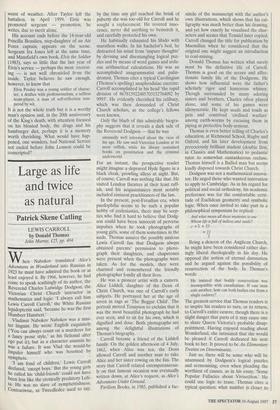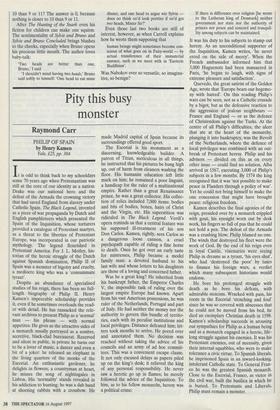Large as life and twice as natural
Patrick Skene Catling
LEWIS CARROLL by Donald Thomas John Murray, £25, pp. 404 When Nabokov translated Alice's Adventures in Wonderland into Russian in 1923 he must have admired the book or at least enjoyed it. By 1966, however, he had come to speak scathingly of its author, the Reverend Charles Lutwidge Dodgson, the Victorian Christ Church instructor in mathematics and logic: 'I always call him Lewis Carroll Carroll,' the White Russian lepidopterist said, 'because he was the first Humbert Humbert.'
Vladimir Nabokov Nabokov was a mas- ter linguist. He wrote English exquisitely (`You can always count on a murderer for a fancy prose style,' as his fictional alter ego put it), but as a character assassin he was a failure. It was Vlad the would-be Impaler himself who was besotted by nymphets. `I am fond of children,' Lewis Carroll declared, 'except boys.' But the young girls he called his 'child-friends' could not have been less like the erotically predatory Loli- ta. He was no slave of nymphettishness. Contrariwise, as Tweedledee used to say, by the time any girl reached the brink of puberty she was too old for Carroll and he sought a replacement. He revered inno- cence, never did anything to besmirch it, and carefully protected his own.
He habitually exhausted his libido with marathon walks. In his bachelor's bed, he distracted his mind from 'impure thoughts' by devising and disentangling logical puz- zles and by means of word games and ardu- ous arithmetical calculations. He was an accomplished anagrammatist and palin- dromist. Thomas cites a typical Carolingian (Thomas's spelling) anaphrodisiac exercise: Carroll accomplished in his head 'the rapid division of 867815922485703152764092 by 9993'. He evidently cherished his celibacy, which was then demanded of Christ Church scholars, as the college's fellows were known.
Only the blurb of this admirable biogra- phy suggests that it reveals a dark side of the Reverend Dodgson — that he was
unusually well informed about the vices of his age. He saw mid-Victorian London at its most raffish, while his library contained books on prostitution and the criminal underworld.
For an instant, the prospective reader might imagine a depraved Hyde figure in a black cloak, prowling alleys at night. But, of course, Carroll was nothing like that. He visited London theatres at their least raff- ish, and his acquaintances most notably included eminent practitioners of the law.
In the present, post-Freudian era, when paedophilia seems to be such a popular hobby of ecclesiastics, there may be scep- tics.who find it hard to believe that Dodg- son could have been innocent of perverse impulses when he took photographs of young girls, some of them sometimes in the nude. Thomas assures the possibly anxious Lewis Carroll fan that Dodgson always obtained parents' permission to photo- graph their daughters, and chaperones were present when the photographs were taken. As for the models, they were charmed and remembered the friendly photographer fondly all their lives.
He was a pioneer artist with a camera. Alice Liddell, daughter of the Dean of Christ Church, was one of Carroll's early subjects. He portrayed her at the age of seven in rags as 'The Beggar Child'. The portrait moved Tennyson to exclaim that it was the most beautiful photograph he had ever seen, and to sit for his own, which is dignified and dour. Both photographs are among the delightful illustrations of Thomas's biography.
Carroll became a friend of the Liddell family. On the golden afternoon of 4 July, 1862, when Alice was ten, the Dean allowed Carroll and another man to take Alice and her sister rowing on the Isis. The story that Carroll related extemporaneous- ly on that famous occasion was eventually written down, at Alice's request, as Alice's Adventures Under Ground.
Pavilion Books, in 1985, published a fac- simile of the manuscript with the author's own illustrations, which shows that his cal- ligraphy was much better than his drawing, and yet how exactly he visualised the char- acters and scenes that Tenniel later copied. Carroll changed the title for publication by Macmillan when he considered that the original one might suggest an introduction to coal-mining.
Donald Thomas has written what surely must be the definitive life of Carroll. Thomas is good on the secure and affec- tionate family life of the Dodgsons. He shows how influential were the father's scholarly rigor and humorous whimsy. Though surrounded by many adoring sisters and brothers, Charles often played alone, and some of his games were idiosyncratic. He kept snails and toads as pets and contrived 'civilised warfare' among earth-worms by encasing them in piping as protective body-armour.
Thomas is even better telling of Charles's education, at Richmond School, Rugby and Oxford, and his later development from precociously brilliant student (double first, in Classics and Mathematics) to pedantic tutor to somewhat cantankerous recluse. Thomas himself is a Balliol man but seems kindly disposed towards Christ Church.
Dodgson was not a mathematical innova- tor. He urged those who wanted innovation to apply to Cambridge. As in his regard for political and social orthodoxy, his academic preference was for the comfortable certi- tude of Euclidean geometry and symbolic logic. When once invited to take part in a philosophical symposium he replied:
And what mean all these mysteries to me Whose life is full of indices and surds?
x2 +7x + 5 3
= I 1 3 Being a deacon of the Anglican Church, he might have been considered rather dar- ingly liberal theologically in his day. He opposed the notion of eternal damnation and he argued against the possibility of resurrection of the body. In Thomas's words:
He insisted that bodily resurrection was incompatible with cannibalism. If one man eats another, how can both bodies rise from a single cadaver?
The greatest service that Thomas renders is to inspire his readers to turn, or to return, to Carroll's entire oeuvre, though there is a slight danger that parts of it may cause one to share Queen Victoria's probable disap- pointment. Having enjoyed reading about Wonderland, she intimated that she would be pleased if Carroll dedicated his next book to her. It proved to be An Elementary Treatise on Determinants.
Just so, there will be some who will be unamused by Dodgson's logical puzzles and sermonising, even when pleading the worthiest of causes, as in his essay, 'Some Popular Fallacies about Vivisection.' He could use logic to tease. Thomas cites a typical question: what number is closer to 10 than 9 or 11? The answer is 0, because nothing is closer to 10 than 9 or 11.
After The Hunting of the Snark even his fiction for children can make one squirm. The sentimentality of Sylvie and Bruno and Sylvie and Bruno Concluded brings blushes to the cheeks, especially when Bruno opens his precious little mouth. The author loves baby-talk:
`Two heads are better than one, Bruno,' I said . . .
`I shouldn't mind having two heads,' Bruno said softly to himself: 'One head to eat mine dinner, and one head to argue wiz Sylvie — doos oo think oo'd look prettier if oo'd got two heads, Mister Sir?'
Even those last two books are still of interest, however, as when Carroll explains how he wrote them supposing that
human beings might sometimes become con- scious of what goes on in Fairy-world — by actual transference of their immaterial essence, such as we meet with in 'Esoteric Buddhism'.
Was Nabokov ever so versatile, so imagina- tive, so benign?



























































 Previous page
Previous page